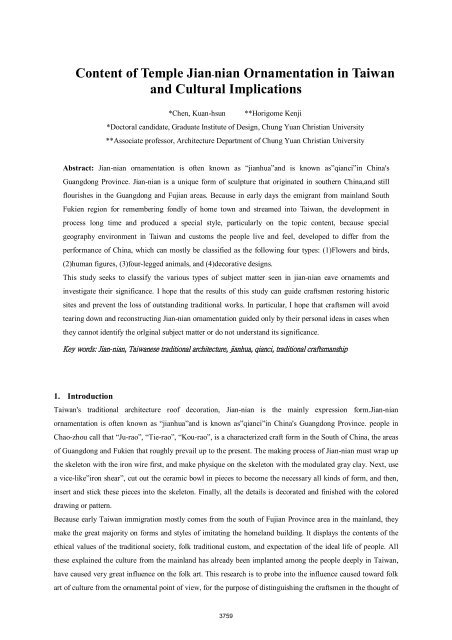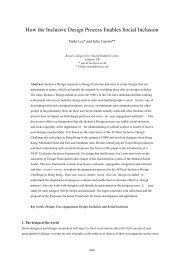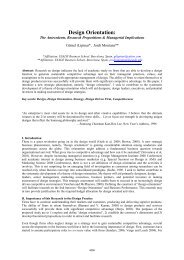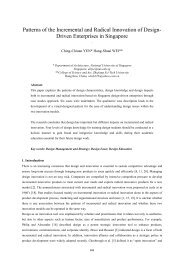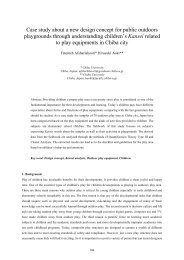Content of Temple Jian-nian Ornamentation in Taiwan ... - iasdr 2009
Content of Temple Jian-nian Ornamentation in Taiwan ... - iasdr 2009
Content of Temple Jian-nian Ornamentation in Taiwan ... - iasdr 2009
Create successful ePaper yourself
Turn your PDF publications into a flip-book with our unique Google optimized e-Paper software.
<strong>Content</strong> <strong>of</strong> <strong>Temple</strong> <strong>Jian</strong>-<strong>nian</strong> <strong>Ornamentation</strong> <strong>in</strong> <strong>Taiwan</strong><br />
and Cultural Implications<br />
*Chen, Kuan-hsun **Horigome Kenji<br />
*Doctoral candidate, Graduate Institute <strong>of</strong> Design, Chung Yuan Christian University<br />
**Associate pr<strong>of</strong>essor, Architecture Department <strong>of</strong> Chung Yuan Christian University<br />
Abstract: <strong>Jian</strong>-<strong>nian</strong> ornamentation is <strong>of</strong>ten known as “jianhua”and is known as”qianci”<strong>in</strong> Ch<strong>in</strong>a's<br />
Guangdong Prov<strong>in</strong>ce. <strong>Jian</strong>-<strong>nian</strong> is a unique form <strong>of</strong> sculpture that orig<strong>in</strong>ated <strong>in</strong> southern Ch<strong>in</strong>a,and still<br />
flourishes <strong>in</strong> the Guangdong and Fujian areas. Because <strong>in</strong> early days the emigrant from ma<strong>in</strong>land South<br />
Fukien region for remember<strong>in</strong>g fondly <strong>of</strong> home town and streamed <strong>in</strong>to <strong>Taiwan</strong>, the development <strong>in</strong><br />
process long time and produced a special style, particularly on the topic content, because special<br />
geography environment <strong>in</strong> <strong>Taiwan</strong> and customs the people live and feel, developed to differ from the<br />
performance <strong>of</strong> Ch<strong>in</strong>a, which can mostly be classified as the follow<strong>in</strong>g four types: (1)Flowers and birds,<br />
(2)human figures, (3)four-legged animals, and (4)decorative designs.<br />
This study seeks to classify the various types <strong>of</strong> subject matter seen <strong>in</strong> jian-<strong>nian</strong> eave ornamemts and<br />
<strong>in</strong>vestigate their significance. I hope that the results <strong>of</strong> this study can guide craftsmen restor<strong>in</strong>g historic<br />
sites and prevent the loss <strong>of</strong> outstand<strong>in</strong>g traditional works. In particular, I hope that craftsmen will avoid<br />
tear<strong>in</strong>g down and reconstruct<strong>in</strong>g <strong>Jian</strong>-<strong>nian</strong> ornamentation guided only by their personal ideas <strong>in</strong> cases when<br />
they cannot identify the orlg<strong>in</strong>al subject matter or do not understand its significance.<br />
Key words: <strong>Jian</strong>-<strong>nian</strong>, <strong>Taiwan</strong>ese traditional architecture, jianhua, qianci, traditional craftsmanship<br />
1. Introduction<br />
<strong>Taiwan</strong>'s traditional architecture ro<strong>of</strong> decoration, <strong>Jian</strong>-<strong>nian</strong> is the ma<strong>in</strong>ly expression form.<strong>Jian</strong>-<strong>nian</strong><br />
ornamentation is <strong>of</strong>ten known as “jianhua”and is known as”qianci”<strong>in</strong> Ch<strong>in</strong>a's Guangdong Prov<strong>in</strong>ce. people <strong>in</strong><br />
Chao-zhou call that “Ju-rao”, “Tie-rao”, “Kou-rao”, is a characterized craft form <strong>in</strong> the South <strong>of</strong> Ch<strong>in</strong>a, the areas<br />
<strong>of</strong> Guangdong and Fukien that roughly prevail up to the present. The mak<strong>in</strong>g process <strong>of</strong> <strong>Jian</strong>-<strong>nian</strong> must wrap up<br />
the skeleton with the iron wire first, and make physique on the skeleton with the modulated gray clay. Next, use<br />
a vice-like”iron shear”, cut out the ceramic bowl <strong>in</strong> pieces to become the necessary all k<strong>in</strong>ds <strong>of</strong> form, and then,<br />
<strong>in</strong>sert and stick these pieces <strong>in</strong>to the skeleton. F<strong>in</strong>ally, all the details is decorated and f<strong>in</strong>ished with the colored<br />
draw<strong>in</strong>g or pattern.<br />
Because early <strong>Taiwan</strong> immigration mostly comes from the south <strong>of</strong> Fujian Prov<strong>in</strong>ce area <strong>in</strong> the ma<strong>in</strong>land, they<br />
make the great majority on forms and styles <strong>of</strong> imitat<strong>in</strong>g the homeland build<strong>in</strong>g. It displays the contents <strong>of</strong> the<br />
ethical values <strong>of</strong> the traditional society, folk traditional custom, and expectation <strong>of</strong> the ideal life <strong>of</strong> people. All<br />
these expla<strong>in</strong>ed the culture from the ma<strong>in</strong>land has already been implanted among the people deeply <strong>in</strong> <strong>Taiwan</strong>,<br />
have caused very great <strong>in</strong>fluence on the folk art. This research is to probe <strong>in</strong>to the <strong>in</strong>fluence caused toward folk<br />
art <strong>of</strong> culture from the ornamental po<strong>in</strong>t <strong>of</strong> view, for the purpose <strong>of</strong> dist<strong>in</strong>guish<strong>in</strong>g the craftsmen <strong>in</strong> the thought <strong>of</strong><br />
3759
creat<strong>in</strong>g. The more important th<strong>in</strong>g is to face these gradually lost craft forms, hope to arouse people's attention to<br />
it, study the discussion aga<strong>in</strong>, and f<strong>in</strong>d our own culture.<br />
2. Research Methods<br />
The research adopts the documental analyses, comparison with the image analyses, and field <strong>in</strong>vestigation<br />
methods to proceed. Study steps and procedures are roughly <strong>in</strong>cluded the follow<strong>in</strong>g three parts:<br />
(1)Document Analysis: Collect materials such as domestic and <strong>in</strong>ternational relevant periodical documents, the<br />
doctor or master’s theses, etc.; analyze and put “traditional architecture”, “<strong>Jian</strong>-<strong>nian</strong> ornamental” and “folk<br />
culture” theoretical bases mean<strong>in</strong>gs <strong>of</strong> relevant documents <strong>in</strong> order; proceed the documental data analyses <strong>of</strong> the<br />
whole <strong>in</strong> many aspects.<br />
(2)Comparison with the Image Data Analyses: Shoot the <strong>Jian</strong>-<strong>nian</strong> ornamental works, then, carry on the<br />
comparison <strong>of</strong> the image data through the bases <strong>of</strong> documental analyses. At the same time, discuss with the<br />
<strong>Jian</strong>-<strong>nian</strong> craftsman what differences between the images and the documents; from understand<strong>in</strong>g the bases<br />
about <strong>Jian</strong>-<strong>nian</strong> ornamental design and cultural mean<strong>in</strong>gs <strong>in</strong> the middle.<br />
(3)Field Investigation: After study<strong>in</strong>g <strong>in</strong> the relevant documents and collect<strong>in</strong>g and digest<strong>in</strong>g the image data,<br />
start the field <strong>in</strong>vestigation. The materials are collected through the methods <strong>of</strong> observation and <strong>in</strong>terviews. On<br />
one hand, understand the forms and trends. On the other hand, understand the craftsman handles the methods and<br />
bases <strong>of</strong> composition and model. Discover the problems from it, <strong>in</strong> order to reconstruct the documental data and<br />
data-prepar<strong>in</strong>g for field <strong>in</strong>vestigation, confirm the documental records, supplement the shortcom<strong>in</strong>gs.<br />
Field <strong>in</strong>vestigation takes <strong>Taiwan</strong> traditional architecture as the core. The choice <strong>of</strong> an <strong>in</strong>terview with the<br />
personages relies ma<strong>in</strong>ly on the craftsmen who are engaged <strong>in</strong> the <strong>Jian</strong>-<strong>nian</strong> ornamental work at present.<br />
3. subject matter content <strong>of</strong> <strong>Jian</strong>-<strong>nian</strong><br />
3-1 subject matter content <strong>of</strong> the flowers and birds’ <strong>Jian</strong>-<strong>nian</strong><br />
In all k<strong>in</strong>ds <strong>of</strong> flowers, the most used one is the tree peony. In addition, there are chrysanthemum, plum blossom,<br />
camellia, water lily, lotus, and so on are <strong>of</strong>ten regarded as the birds and flowers' subject matter, too. Because<br />
they have someth<strong>in</strong>g to do with monthlies and seasons, the frequency <strong>of</strong> their occurrence is higher than other<br />
flowers and plants. aforesaid several flowers <strong>of</strong>ten appear with the form <strong>of</strong> “great four seasons”, (spr<strong>in</strong>g plum<br />
blossom, summer lotus, autumn chrysanthemum, and w<strong>in</strong>ter camellia). Besides flowers are related to monthlies<br />
and seasons, flowers also have their own special mean<strong>in</strong>gs. In addition to all <strong>of</strong> the above, some flowers also<br />
<strong>of</strong>ten put together that symbolize the similar mean<strong>in</strong>g, and become an aggregate theme 1 .<br />
In obta<strong>in</strong><strong>in</strong>g materials from birds, phoenix is a common subject matter. The spiritual phoenix will appear only<br />
when the wise monarch was born. Because the phoenix has a so l<strong>of</strong>ty position, <strong>of</strong>ten become one <strong>of</strong> the<br />
protagonists on <strong>Jian</strong>-<strong>nian</strong> ornament. Besides phoenix, there are still some other left, cranes, roosters, egrets,<br />
peacocks, magpies, swallows, eagles, golden pheasants and etc.<br />
1 For example: ' four gentlemen ' - Plum, orchid, bamboo, chrysanthemum; ' four loves ' - Orchid, lotus, plum,<br />
chrysanthemum; ' four purities ' - Plum, sweet-scented osmanthus, chrysanthemum, narcissus; ' four flowers ' -<br />
Plum, narcissus, orchid, w<strong>in</strong>tersweet, and etc.<br />
3760
3-2 Subject matter content <strong>of</strong> the human figures’ <strong>Jian</strong>-<strong>nian</strong><br />
The early agricultural society <strong>of</strong> <strong>Taiwan</strong> pays attention to the order <strong>of</strong> ethics, the ideas <strong>of</strong> good and evil, and<br />
emphasizes the spirit <strong>of</strong> the loyalty, filial piety, courtesy, and justice. <strong>in</strong> order to achieve the purpose to enlighten<br />
human heart. The decorations <strong>of</strong> the temple obta<strong>in</strong> materials from everybody's fairy tales, historical allusions or<br />
opera novels that what's frequently heard can be repeated <strong>in</strong> detail naturally. In the folk mythical legend, the<br />
most familiar one is the legend <strong>of</strong> the Eight Immortals. The models <strong>of</strong> the Eight Immortals are also Ch<strong>in</strong>ese's<br />
favorite patterns, apply to life extensively; they mean to express good wishes and longevity, and are also been<br />
the lucky symbol that avoids evil spirits. Its become one <strong>of</strong> the craftsmen's favorite subject matter. Besides,<br />
fu-lu-shou 2 is the subject matter that <strong>of</strong>ten appears. Because it represents people's supreme expectation and<br />
ideal, fu-lu-shou is always placed <strong>in</strong> the showiest position <strong>of</strong> the centrally located “zheng-ji (ma<strong>in</strong> ridge)”.<br />
Besides fairy tales, the human figures ornamental subject matter <strong>of</strong>ten obta<strong>in</strong>s materials from the traditional<br />
novel, all based on an <strong>in</strong>tact story, also focus on the story content, choose to conform with the plot <strong>of</strong> the<br />
traditional social moral concept, express noble sentiment such as loyalty, filial piety, etiquette, and justice, reach<br />
and teach the loyal social education function <strong>of</strong> teach<strong>in</strong>g the filial piety by this.<br />
3-3 Subject matter content <strong>of</strong> the four-legged animals’ <strong>Jian</strong>-<strong>nian</strong><br />
The dragon is one <strong>of</strong> Ch<strong>in</strong>ese's favorite totems, and the first <strong>of</strong> “four Spiritual beasts” 3 , so no matter <strong>in</strong> the palace<br />
or temple <strong>of</strong> the architecture, the dragon becomes most frequent animal.<br />
Ch<strong>in</strong>ese unicorn, god beast <strong>of</strong> legend, one <strong>of</strong> four Spiritual beasts, symbolizes an auspicious sign. In the folk<br />
legend, the Ch<strong>in</strong>ese unicorn is <strong>of</strong>ten ridden by the immortal, has the ability <strong>of</strong> avoid<strong>in</strong>g ghost and evil, so it is<br />
placed on the ro<strong>of</strong> and becomes the symbol that pursues good fortune and avoids disaster. The most common<br />
shape is that the back <strong>of</strong> the Ch<strong>in</strong>ese unicorn carries a boy 4 .In the subject matter <strong>of</strong> the beasts, “four beasts” is<br />
the common subject matter, too. Four beasts mean the tiger, leopard, lion, and elephant, four k<strong>in</strong>ds <strong>of</strong> animals.<br />
Folk <strong>in</strong> <strong>Taiwan</strong>, these four efficacious beasts are related to Buddhism and Taoism. Nearly can see their images <strong>in</strong><br />
each temple<br />
3-4 subject matter content <strong>of</strong> the decorative designs’ <strong>Jian</strong>-<strong>nian</strong><br />
The ornamental k<strong>in</strong>ds’ <strong>Jian</strong>-<strong>nian</strong> is for decorat<strong>in</strong>g a design at an unimportant position and for strengthen<strong>in</strong>g the<br />
build<strong>in</strong>g’s component. The ornamental composition subject matter <strong>of</strong> this k<strong>in</strong>d mostly takes pattern content as<br />
the core. It is roughly divided <strong>in</strong>to the follow<strong>in</strong>g four k<strong>in</strong>ds: (1)Flowers and fruits, (2)Aquatic organisms, (3)and<br />
(4)Auspicious items.<br />
(1)Flowers and fruits: This subject matter <strong>of</strong> flowers is generally pattern<strong>in</strong>g. its form with the curve accord<strong>in</strong>g to<br />
the growth state <strong>of</strong> the trail<strong>in</strong>g plant. Because <strong>of</strong> the shaped characteristic jo<strong>in</strong>s the beg<strong>in</strong>n<strong>in</strong>g to the end,<br />
symbolizes the mean<strong>in</strong>g <strong>in</strong> succession; it is also a symbol <strong>of</strong> fir<strong>in</strong>g prevention.The pattern <strong>of</strong> fruits is <strong>in</strong> the<br />
2 Called “cai-zi-shou” from <strong>Taiwan</strong> local craftsmen.<br />
3 The dragon, phoenix, tortoise, Ch<strong>in</strong>ese unicorn are jo<strong>in</strong>tly called “four Spiritual beasts”.<br />
4 accord<strong>in</strong>g to the records <strong>of</strong> “the picture <strong>of</strong> holy trace” : “Confucius was born, sees Ch<strong>in</strong>ese unicorn and jade<br />
book.” So, “gi-l<strong>in</strong>-song-zi (give a son by Ch<strong>in</strong>ese unicorn)” means the birth <strong>of</strong> an excellent person, the boy that<br />
Ch<strong>in</strong>ese unicorn sends here; it is a good talent <strong>in</strong> the century after grow<strong>in</strong>g up, and a virtuous <strong>of</strong>ficial who assists<br />
the country.<br />
3761
application on <strong>of</strong> <strong>Jian</strong>-<strong>nian</strong>, reflects the expectation <strong>of</strong> rich life <strong>in</strong> the agricultural society. The fruit that <strong>of</strong>ten<br />
appear take native fruit <strong>in</strong> <strong>Taiwan</strong> as the core.These fruits mostly because <strong>of</strong> their characteristics or assonance,<br />
and is enclosed <strong>in</strong> order to the mean<strong>in</strong>g <strong>of</strong> an auspicious bless<strong>in</strong>g.<br />
(2)Aquatic organisms: <strong>Taiwan</strong> is surrounded by sea because <strong>of</strong> the topography <strong>of</strong> island country, It is very<br />
natural result to use the aquatic organisms to be the ornamental subject matter, has formed the characterized<br />
ornamental style because <strong>of</strong> this. Because the aquatic organisms belong to the property <strong>of</strong> water, they also have<br />
the mean<strong>in</strong>g <strong>of</strong> suppress<strong>in</strong>g God <strong>of</strong> fire by this.<br />
(3)Auspicious items: S<strong>in</strong>ce Ch<strong>in</strong>ese ancient times, the craft <strong>of</strong> the implements is extremely developed and also<br />
become the <strong>in</strong>dispensable element <strong>in</strong> life. The craftsmen will utilize shape <strong>of</strong> the implements naturally as the<br />
pattern <strong>of</strong> the build<strong>in</strong>g decoration. These implements <strong>of</strong> l<strong>in</strong>e decorations reflect the ideal life that people expect,<br />
and <strong>in</strong>clude the symbol mean<strong>in</strong>g <strong>of</strong> good luck and repell<strong>in</strong>g evil spirits. The craftsmen <strong>of</strong>ten make this k<strong>in</strong>d <strong>of</strong><br />
subject matter up <strong>in</strong>to “bo-gu-tu” 5 ; it is for the decoration <strong>of</strong> ro<strong>of</strong> ridge and symbolizes grace and purity.<br />
4. Conclusion<br />
The construction <strong>of</strong> the temple is an important major issue <strong>in</strong> the traditional agricultural society. As regards to<br />
decorate build<strong>in</strong>gs, be can't ignored certa<strong>in</strong>ly and quite pays attention to craftsman's exquisite degree <strong>of</strong> skill. In<br />
Ch<strong>in</strong>ese traditional art, the development <strong>of</strong> craft takes the architectural decoration, skill, and the spread folk<br />
culture as the cores. The content mentioned comprehensive <strong>in</strong> the front, no matter birds and flowers, personages,<br />
beast, or ornaments, these four k<strong>in</strong>ds <strong>of</strong> subject matter exist because <strong>of</strong> abundant architectural aesthetic feel<strong>in</strong>g,<br />
br<strong>in</strong>g abundant folk culture subject matter to us, make us understand own impact on folk art <strong>of</strong> culture, it has<br />
many abundant pattern and subject matter, has a lot <strong>of</strong> amaz<strong>in</strong>g ones, the speciality produced because <strong>of</strong> change<br />
<strong>of</strong> time. These expla<strong>in</strong>ed that Ch<strong>in</strong>ese culture is the creation <strong>of</strong> diversification, many systems, and many<br />
angles.F<strong>in</strong>ally, today <strong>in</strong>to the 21st century really can not let these that characterized craft forms <strong>in</strong> the South <strong>of</strong><br />
Ch<strong>in</strong>a disappear. To us, these unique craft forms lead us to pass by from the system <strong>of</strong> folk culture; let us<br />
understand our culture is not poor, life is not dull, either, just we have forgotten too much.<br />
5. reference<br />
[1]Li Qian-Lang,(1993) Chao-tian-gong’s architecture and decorative art <strong>in</strong> Bei-gang , Yun-l<strong>in</strong>, f<strong>in</strong>ancial group<br />
<strong>of</strong> Bei-gang Chao-tian-gong,.<br />
[2]Li Qian-Lang,(1998) Build<strong>in</strong>g history <strong>of</strong> <strong>Taiwan</strong> , Xiong-Shi Publish<strong>in</strong>g Co., Taipei<br />
[3]Li Cang-Yan,(1998)Ch<strong>in</strong>ese lucky pattern , Nan-Tian Books Company, Taipei.<br />
[4]Li Yun-Her, (2005)Cathay’s Idea-Design Theory <strong>of</strong> Ch<strong>in</strong>ese Classical Architecture , Tianj<strong>in</strong> University Press,<br />
Tianj<strong>in</strong>.<br />
[5]Y<strong>in</strong> Deng-Guo,(1983)Flower Spirit and Solar Terms <strong>of</strong> Ch<strong>in</strong>a , M<strong>in</strong>-Sheng Newspaper Office, Taipei .<br />
[6]Xi De-J<strong>in</strong>, (1976)Folk Art <strong>of</strong> <strong>Taiwan</strong> , Xiong-Shi Publish<strong>in</strong>g Co., Taipei.<br />
[7]Makoto Kon Nozaki , (1994)Ch<strong>in</strong>ese Lucky Pattern , Zhong-Wen BooksCo., Taipei.<br />
[8]Chen Kuan-Hsun ,(2001)Ridge <strong>of</strong> <strong>Taiwan</strong> Traditional Architectural Ornamental , history relic-Journal <strong>of</strong> the<br />
National Museum <strong>of</strong> History Museum , vol. 11, no. 6 , pp 25~ 33.<br />
5 Accord<strong>in</strong>g to legend, Hui-Zong <strong>in</strong> Northern Song Dynasty orders a group <strong>of</strong> people, such as, Wang-Fu to<br />
compile the ancient objects <strong>in</strong> the hall “xuan-he-dian” <strong>in</strong>to “xuan-he-bo-gu-tu”.<br />
3762


